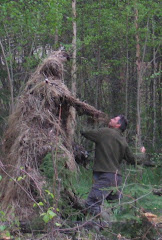 In Canmore, owing to the bears, it is verboten to have outdoor composters. So our indoor vermiculture worms have been busy converting our vegetable waste into topsoil. I wasn't big on the idea at first as there is an occasional odor from the worm box. You might say they bring odor out of chaos. But after our first big harvest of soil, I'm definitely a convert. I no longer need to buy topsoil which I badly needed for my indoor plant pursuits.
In Canmore, owing to the bears, it is verboten to have outdoor composters. So our indoor vermiculture worms have been busy converting our vegetable waste into topsoil. I wasn't big on the idea at first as there is an occasional odor from the worm box. You might say they bring odor out of chaos. But after our first big harvest of soil, I'm definitely a convert. I no longer need to buy topsoil which I badly needed for my indoor plant pursuits.
These piles are just the worm castings. What was once table scraps is now very productive (and odorless) topsoil. We even had enough to share with some gardening friends from Calgary.
After scooping into piles, the worms scurry to the bottom of each pile where they can be easily collected and returned to their box.
As I'm off to the woods this weekend for a few months, I'll have to wait till I return to put the soil to use but I'm anxious to see how productive it is.



5 comments:
There is more complexity in a cup of soil than in the entire solar system.
The interelationships between microflora in their millions, the chemistry and physics of nutrient movement and energy transfer is a thing to behold.
Everyone should learn more about soil and less about politics.
I like the image of worms scurrying.
What, you expect them to just crawl around?
They've got a lot of s**t to take care of!
I assume it is only table scraps that can't be composted. Seems like there couldn't be any way around leaves, grass and garden waste. Unless you burn it, I suppose?!?
Glad it was such a success. Does that represent all the scraps from the winter, or did you discard some?
I'm taking your advice Kevin and will undertake some soil education beyond my simplified understanding.
Mike you're right about yard waste but I think most people take it to a municipal site where it's dealt with in an animal controlled environment. There's not much yard waste around here anyway. Few leaf trees and few lawns. Just the other night all the lawns on our cul de sac got trimmed by some hungry deer in an hour.
As for any scrap surplus, we have quite a backlog of frozen scraps in the freezer as our consumption to worm decomposition rate was a bit off. With more space we could have had a set up that converted at our consumption rate. While I'm gone for a few months, the surplus will get used up I think.
Plant macronutrients, N,P,K and S when sourced from natural sources like compost or animal wastes can typically replace their synthetic chemical equivalents by a factor of 10:1.
So a 20:20:20 chemical fertilizer has the same power as a natural fertilizer of only 2:2:2.
Composts and animal wastes easily fall into this range.
Nobody has figured out why natural fertilizers are so much more powerful than synthetic. This is a mystery that many scientists either refuse to acknowledge or admit that it is unexplained. No one is researching why this is. I think it is too far beyond scientists' paradigm and nobody wants to stray from their safe and secure grant structure without being seen as a crackpot.
This is exactly why scientific innovation is proceeding at a crawl rather than a gallop.
Dave, I have a fabulous book on plant nutrient relationships. It is called "Mineral Nutrition of Higher Plants" by Marschner. It is like a rich dessert that must be savoured in small doses. But if you want an intellectually rewarding workout and read, this book is for you.
If you ahve a reasonable background in "street" chemistry and physics, you will be able to appreciate it.
Post a Comment